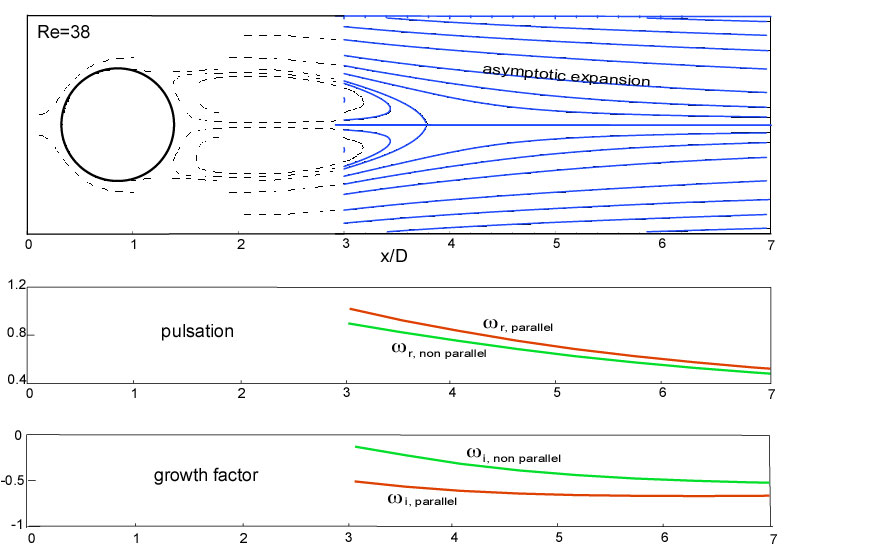
| These
experiments deal with the interaction between non-thermal plasma and
gas flows, where non-thermal plasma is created by DC or AC discharges.
The possible plasma-gas flow interactions cover a wide field
of research, virtually including flow control problems, free coupling of electrical and inertia forces and even plasma control by means of an airflow. |
| Powered multi-tip DBD on the leading edge of a NACA0015 airfoil |
Separation control by corona discharge at low Reynolds numbers |
 |
| Electrohydrodynamic
propulsion in atmosphere is a promising technology aimed to create
thrust by exploiting the ionic wind generated by suitable devices. It provides several advantages such as absence of moving parts and low noise production. Recent developments point out the importance of electrodes design to maximize thrust and reduce aerodynamic drag. |
| Propulsion system at test bench | Photograph of the system sketched in the left panel |
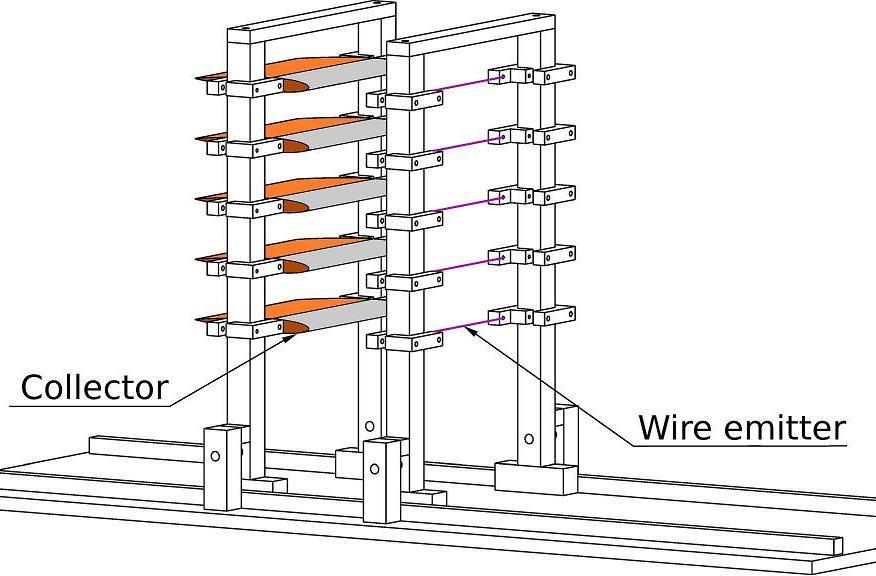 |
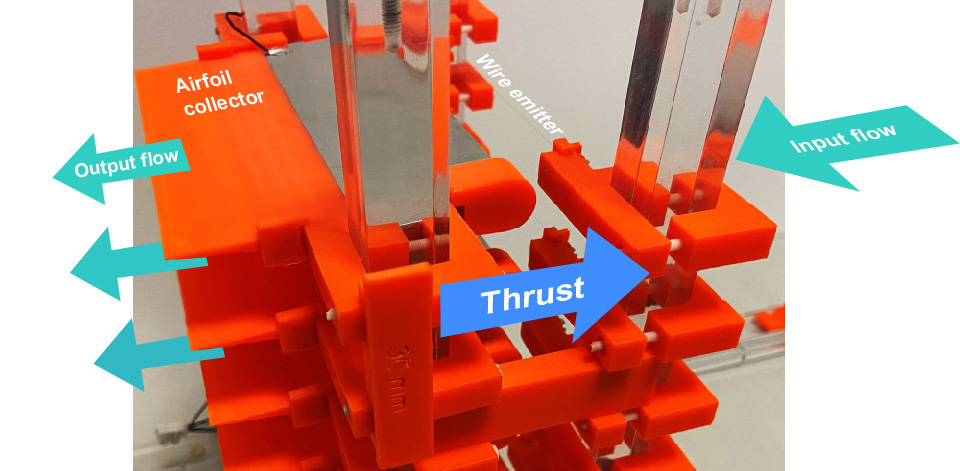 |
| The
plasma actuators are widely studied because of their ability to produce
a ionic wind, that can be used for several flow control purposes. The
shape of the electrodes seems to be a very important parameter: in
particular, multiple tips on the edge of the active electrodes can
improve the efficiency of the actuators. |
| Sketch of the gas flow generated by a multi-tip corona actuator |
Sketch of the gas flow generated by a multi-tip DBD actuator |
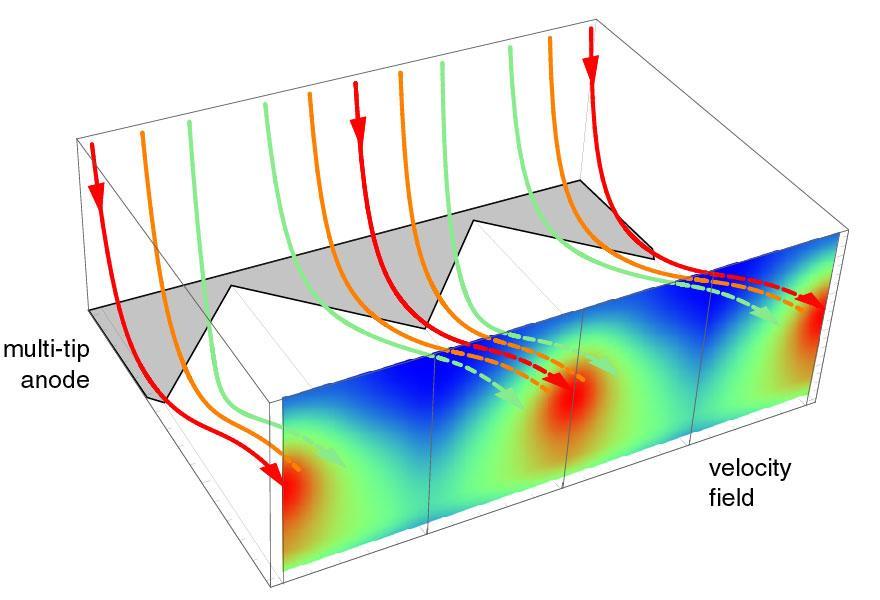 |
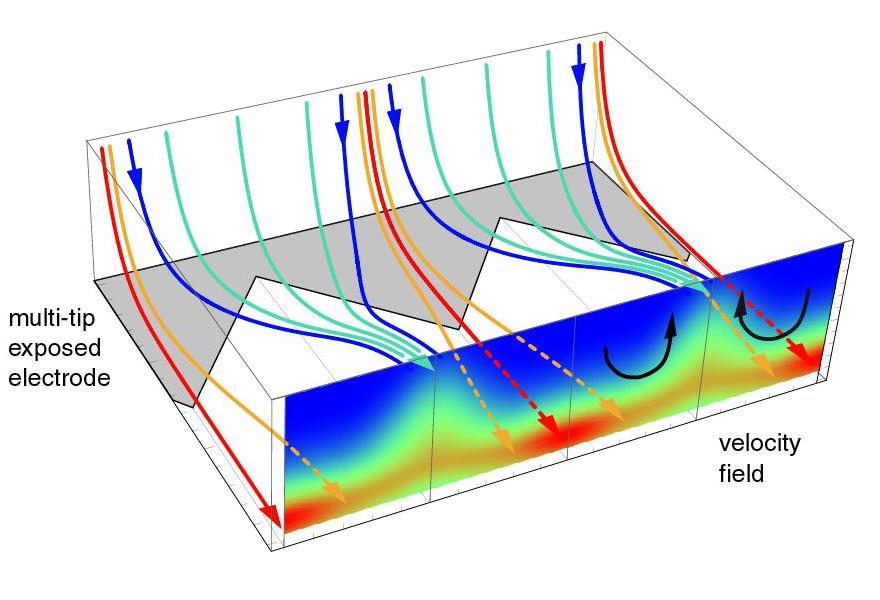 |
| Flow
control by means of DBD actuators creates local tridimensional flow
even when the basic flow is bidimensional. When also the basic
flow is inherently tridimensional, the flow topology may
remarkably differ from simplified plane representations obtained for
instance by a longitudinal section close to the centerline. |
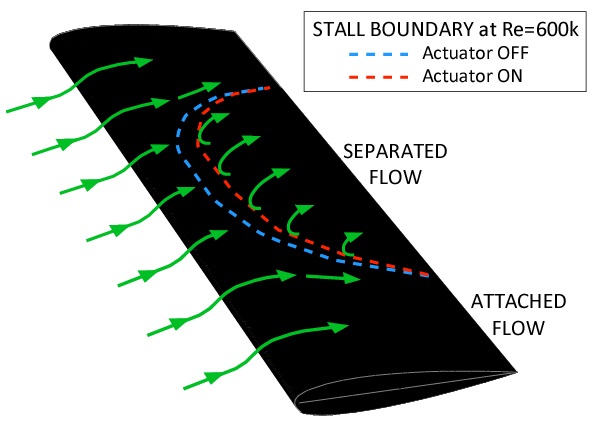 |
Action
of a multi-tip DBD actuator installed on the leading edge of a wind
tunnel airfoil. The finite span creates a naturally 3D separation which
is modified by plasma flow control. |
| The
corona discharge is widely known, with numerous applications ranging
from engineering to chemistry and medicine. The technology
for creating it in a volume of gas is well established, whereas
the development of a corona discharge along a surface is difficult.
Surface corona discharges can be stabilized by feeding an electrode
with multiple tips by a suitable waveform. |
| Pulsed generator for surface corona devices | Operating principle |
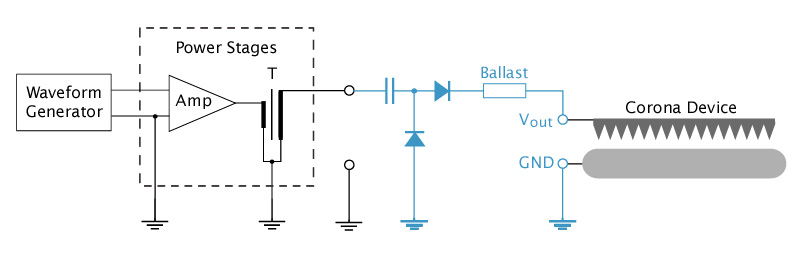 |
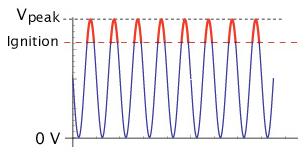 |
| This
research project is devoted to the study of hypersonic underexpanded
and nearly matched jets. The flows considered
here are important
both in fluid dynamics and in astrophysics. The facilities are
suitable for investigating the spatial evolution of a jet over long
scales, in the order of hundreds of initial diameters. It is possible
to set the
jet-to-ambient density ratio and the jet Mach number independently of
each
other, this is obtained using different gases for the jet
and the ambient. Observations and measurements are
performed by means of an electron gun (designed and built in this
laboratory), that makes possible to get fluorescent plane sections of
the
jets, acquired as digital images. After suitable
image processing,
thanks to an original method purposely developed, each image becomes a
measurement field where density and concentration maps of the different
gases can be obtained: this gives information on jet substructures,
compressible lateral mixing, and long term jet spreading. |
| Left panel: an argon
jet flowing in
an helium ambient, Mach number upstream of the normal shock >
30. Right panel: a pair of Ar concentration curves along radial sections: jet/ambient mixing is more effective after the normal shock. |
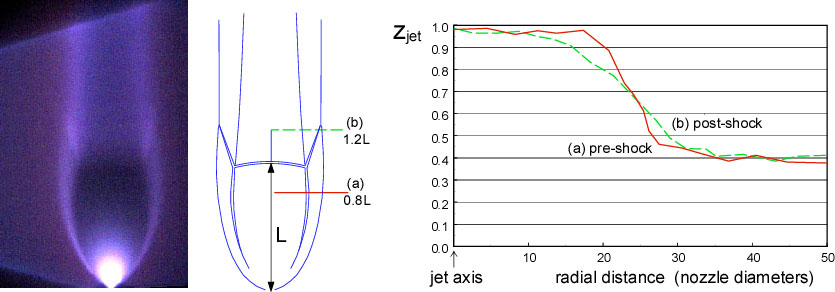
| An
experiment run in the same facilities as above is devoted to the
study of nearly matched jets issuing from de Laval nozzles.
These jets have Mach numbers (5 to 20) and
jet/ambient density ratios (0.1 to 100) in the same range of the
stellar
jets
known in astrophysics by direct observations and widely studied by
means of numerical simulations.The lab
tests show that many
properties of the stellar jets can be explained in terms of pure fluid
dynamics, since MHD and radiation effects are not included in this
experiment. In particular, the jet
morphology exhibits many known structures as bow and terminal shocks,
backward flow cocoons
and compression
knots . |
| The research program involves: + Politecnico di Milano, + Universita' di Torino, + Politecnico di Torino, + Max-Planck-Institute for Dynamics and Self-Organization - Göttingen |
| The ubiquity of turbulent flows, with their large frictional drag brought about by momentum diffusion, makes the reduction of such drag an objective of pervasive importance in many applications. A new method for forcing a turbulent flow, based on streamwise-traveling waves of spanwise velocity at the wall, is tested by means of an experiment, where a pipe was built with the capability of producing the required wall forcing. The drag reduction can reach 30% and more, with saved energy larger than the control energy by almost two orders of magnitude. |
| Experiment
setup: a turbulent flow in a pipe is forced at the wall by a tangential
velocity of the kind 'travelling wave'  |
Drag
reduction DR (%) at Re=5000: a comparison between DNS results (grid
surface) and experimental results (large dots fall above the surface, small dots fall below) as functions of frequency and wavenumber of the travelling wave |
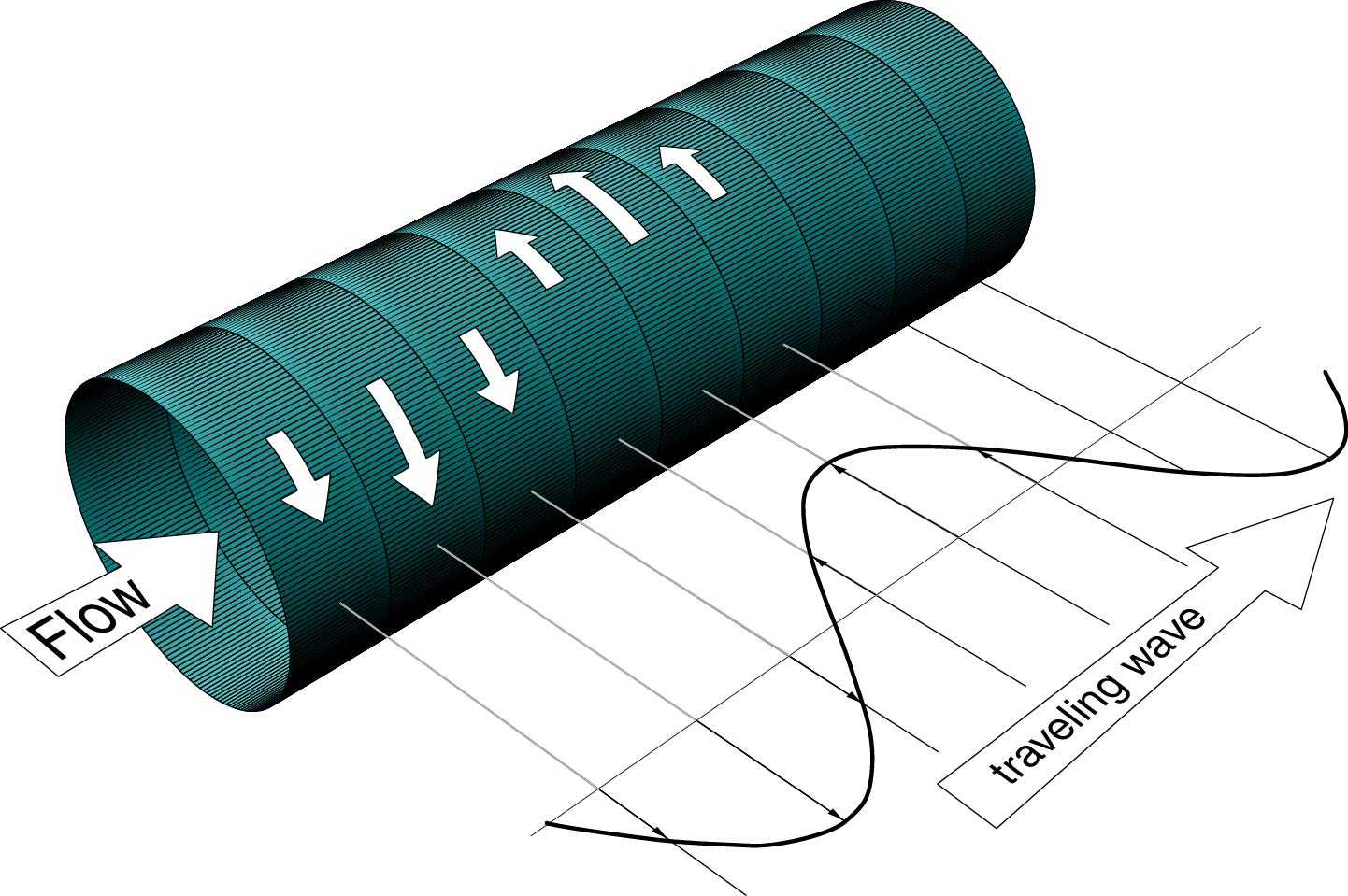 |
 |
| The study of turbulent flow in helically coiled pipes is important both for its engineering applications and its scientific interest. Aim of this research project is to describe the turbulent flow in a helical pipe of circular cross-section, and in particular to study the secondary structures in turbulent conditions with an endoscopic Particle Image Velocimetry (PIV) technique. |
| A well known problem in wind engineering is the flow around two bodies in tandem configuration. This experimental investigation studies the important case of two flat plates at 90o incidence. The experiment is carried out by means of smoke visualizations, hot wire (HWA) and laser doppler (LDA) anemometry. Accurate measurements of the Strouhal number were obtained for plate separations ranging from 0.25 chords to 7.5 chords. Different flow regimes are described, depending on the distance between the plates, by exploiting the Strouhal number behaviour and the flow visualizations. A narrow interval of distances where two regimes alternatively appear is found; this intermittence is reported in detail by means of simultaneous visualizations, HWA and LDA measurements. Mean and instantaneous flows fields between the two plates and past the aft plate are determined by LDA for each configuration. |
| ______________________
Graphical outline of the bistable flow ___________________ |
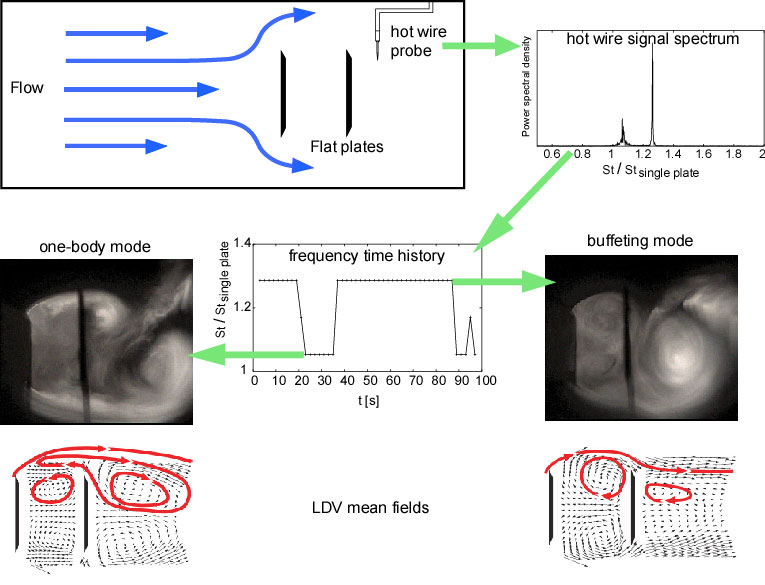
| __________________ One-body mode measurements : __________________ |
Vorticity
and velocity fields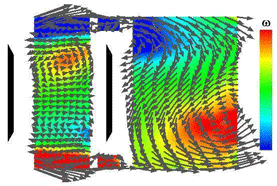 |
Visualization
and velocity field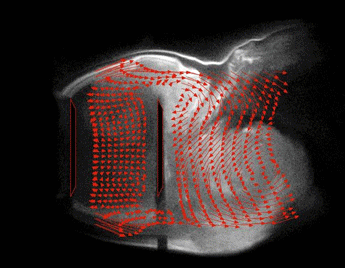 |
Example: a
DC motor closed-loop velocity controller.
Input: any velocity waveform, Vpp>1.5V; Output: 100W (up to 42Vpp for DC motors from 6 to 24V) (click on the figure to enlarge) |
| The
reference flow under study is the
cylinder wake at
low Re
numbers,
altough the theory may be easily
generalized to other wakes. The
early works are based on weakly
nonlinear models. The most
recent make use of a multiscale approach where 1/Re
is the
small parameter: by
introducing a spatio-temporal
multiscaling into a linearized instability model, a
hyerarchy of ODEs is obtained. The
first one is a parametric Orr-Sommerfeld equation, the second
one is an inhomogeneous equation that gives the non-parallel
corrections to the eigenvalues found at the first step, and leads to a
modulation equation for the instability wavetrains.The streamwise
variation of the instability characteristics can then be deduced from
the wave modulation, as a function of the perturbing wave
numbers. It
is found that the non-parallel effects are not negligible, and that the
absolute instability region in the first wake is larger than
what
calculated from a parallel model. The dominant frequencies found here
are in good agreement with the global modes of the wake known in
literature. |
| Top to bottom: - analytic velocity field (blue streamlines) for the cylinder wake at Re=38 - local instability pulsation with and without non parallel effects - local instability growth rate with and without non parallel effects |
